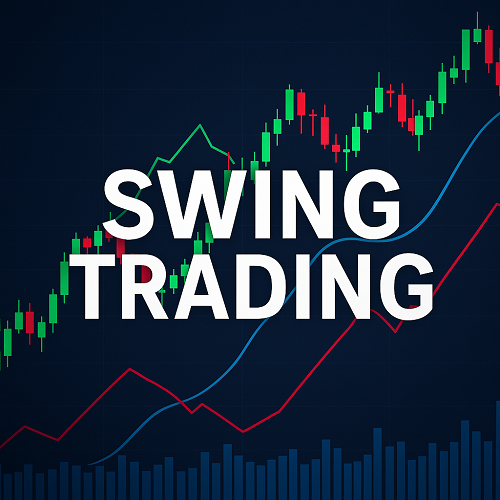As financial markets fluctuate, many traders aim to exploit shorter-term price moves—more than a day but less than a long-term investment horizon. This is where swing trading comes in: it stands between day trading and position investing.
In this comprehensive guide, you’ll learn:
- What swing trading really is (beyond textbook definitions)
- Why it appeals to many active traders
- How to build and execute profitable swing setups across assets
- How to manage risk, emotions, and consistency
- Specific examples in stocks, forex, and cryptocurrencies
By the end of this article—even if you’re relatively new—you’ll understand how to craft your own swing trading approach with clarity and confidence.
What Is Swing Trading?
Swing trading is a style of active trading focused on capturing short- to medium-term moves in price—typically from a few days up to several weeks (rarely longer). The goal is to capture “swings” in the trend: when price undergoes a corrective move, and then resumes its dominant direction.
Key features of swing trading include:
- Holding periods: days to weeks (rarely intraday-only)
- Use of technical analysis rather than fundamental analysis (though fundamentals can provide context)
- Emphasis on risk-reward, entry/exit discipline, and trade management
- Operating in trending, consolidating, or trading-range markets
Swing traders aim to avoid the ultra-short noise of intraday trading, while still benefiting from more frequent opportunities than long-term investing.
“Markets rarely go in a straight line—they swing. Good swing traders aim to surf those waves.”
Note: Swing trading is fundamentally different from both day trading (closing all positions each day) and long-term investing.
Why Choose Swing Trading: Pros & Cons
Pros / Advantages
- Lower time pressure
You don’t have to stare at charts all day. You can scan setups, enter, and monitor intermittently. - Fewer trades, higher conviction
You can be more selective, waiting for confluence and stronger signals. - Better risk-reward potential
You can aim for multi-day moves, not just intraday scalps. - More flexibility
Suits part-time traders who have a job or limited screen time. - Avoids pattern day trader rules (in U.S.)
Because positions last more than a day, you’re less likely constrained by regulatory intraday rules.
Cons / Disadvantages & Risks
- Overnight / weekend risk
You are exposed to gap risk when markets are closed (e.g., news, earnings, macro). - Whipsaws and false reversals
Markets frequently reverse sharply and invalidate setups. - Missed large trends
If a major trend forms, swing traders sometimes exit too early. - Requires patience & discipline
Holding through volatility demands emotional control. - Slower capital turnover
Because trades last days/weeks, your capital is tied up longer than with intraday styles.
Swing vs. Other Trading Styles
| Style | Time Horizon | Frequency | Focus / Tools | Pros | Cons |
|---|---|---|---|---|---|
| Day Trading | Minutes–hours | High | Intraday price action, volume, fast indicators | High turnover, many opportunities | High stress, high commissions, tighter risk |
| Swing Trading | Days–weeks | Moderate | Trend analysis, support/resistance, momentum oscillators | More time flexibility, capture bigger moves | Overnight risk, fewer signals |
| Position / Trend Investing | Weeks–months or more | Low | Fundamentals + technical trend, macro context | Ride major trends, lower transaction costs | Less opportunity, slow feedback |
When you’re deciding which to use, think: how much screen time do you have, how much risk can you tolerate, and what markets you prefer? Swing trading is a balanced “middle path.”
Core Principles of Swing Trading
Before diving into setups, any robust swing approach should rest on these pillars:
- Trend identification & alignment
You want to trade in harmony with the dominant trend, not always against it. - High-probability entries
Only take setups that meet multiple criteria (confluence of indicators, price action, structure). - Defined risk & stop strategy
Every trade should have a predetermined stop-loss — you must know your maximum loss before entering. - Calculated reward targets
Aim for favorable risk-to-reward—e.g., risking 1 unit to gain 2–3. Avoid low reward trades without very high win rate. - Trade management / scaling / exit rules
Decide whether you’ll scale out, move stops, trail, or exit partial positions. - Adaptability across markets
The same setup may need minor tweaks when applied to stocks vs forex vs crypto. - Backtesting & forward testing
Before committing real money, validate your edge via historical data (backtest) and demo or small live sample (forward test). - Consistent journaling & review
Study your trades—winners and losers alike—for continuous improvement.
Swing Trading Strategies & Setups
Here’s a catalog of the most commonly used and battle-tested swing strategies — along with variations and entry tactics.
Trend Pullback / Retracement Strategies
Concept: Ride the dominant trend, entering after a pullback that shows exhaustion (i.e. price temporarily moves against the trend, then reverses back in trend direction).
Common methods:
- Moving average bounce: Price dips to a moving average (e.g. 8, 20, 50) and then reverts direction.
- Fibonacci retracement levels: After a move, price pulls back to 38.2%, 50%, or 61.8% zones before resuming direction.
- Trendline / channel pullbacks: Price touches or nears trendline, channel edge, or parallel channel midzones.
- Pivot-based pullbacks: Price returns to a prior swing point or zone of interest (e.g. prior resistance turned support).
Entry signals (for confirmation):
- A bullish (or bearish) candlestick reversal pattern (hammer, pin bar, engulfing)
- Momentum confirmation (e.g. RSI rising from oversold, MACD cross)
- Volume increase or above-average volume validating move
- Price breaks above the high (for long) or below the low (for short) of the retracement sequence
Example:
In an uptrend, price pulls from $100 → $120, then retraces down to $110 (Fibonacci 50%) and touches the 20 SMA. You wait for a bullish engulfing or reversal bar, confirm with RSI or MACD, and enter.
Breakout & Continuation Strategies
Concept: Identify restful zones or consolidations (rectangles, wedges, triangles, basing patterns) and enter when price breaks out, expecting continuation.
Execution elements:
- Entry on breakout candle: Price closes above resistance (long) or below support (short).
- Volume confirmation: Breakout should ideally occur with expanding volume.
- Retest entries: After the breakout, the price often retests the breakout level; you can enter on the retest.
- Filter using structural context: Ensure breakout direction aligns with broader trend to reduce false breakouts.
Mean Reversion / Countertrend Strategies
Concept: In range-bound markets, price tends to revert to mean (midline, moving average) after extended move. Here, entries are taken from extremes.
- Use overbought/oversold indicators (RSI, Stochastic, Bollinger Bands)
- Confirm exhaustion divergences (e.g. RSI divergence vs price)
- Limit risk strictly (since reversals may not fully occur)
- Usually shorter holds — may last 1–3 days
Because these trades go against trend (or within sideways markets), they are riskier and have lower win rates. But when executed with proper filters, they can be supplementary.
Pattern-Based Strategies
Chart patterns remain among the most trusted tools among swing traders. Key ones include:
- Head and Shoulders / Inverted
- Double tops / double bottoms
- Cup and Handle / Saucer
- Flags and Pennants (continuation)
- Triangles (ascending, descending, symmetric)
- Rectangles / Ranges
Patterns provide built-in structure (entry, stop, target). But they require confirmation and sometimes volume or momentum validation to reduce false signals.
Indicator Combinations & Confluence
Rather than relying on one indicator, high-performing swing systems use confluence — multiple signals aligned.
Examples:
- Price at a Fibonacci retracement zone and touching a moving average
- RSI showing bullish divergence plus price reversal candle pattern
- MACD crossover in direction of trend at prior support/resistance
- Volume spike at breakout and confirmation from momentum
The more independent signals align, the stronger the edge.
Time Frames, Tools & Indicators
Swing traders commonly use a multi-timeframe approach:
- Higher timeframe (HTF): daily, 4-hour to gauge trend and major support/resistance
- Intermediate timeframe (ITF): 1-hour or 2-hour for refining entries
- Lower timeframe (LTF): 15-min or 5-min for precise entries (optional)
Common Indicators & Tools
| Tool / Indicator | Use / Purpose |
|---|---|
| Simple/Exponential Moving Averages (SMA, EMA) | Trend confirmation, dynamic support/resistance |
| RSI (Relative Strength Index) | Overbought/oversold, divergences |
| MACD (Moving Average Convergence Divergence) | Trend/momentum crossover signals |
| Bollinger Bands | Volatility bands to gauge extremes |
| ATR (Average True Range) | Volatility measurement, position sizing & stop distance |
| Fibonacci Retracements / Extensions | Target and entry zones |
| Support & Resistance Zones | Natural barriers and breakout levels |
| Candlestick Patterns | Reversal / confirmation signals |
| Trendlines & Channels | Framework for price structure |
Volatility-based stops (e.g. ATR multiples) are often better than arbitrary fixed tick stops, as they adapt to the asset’s current movement.
Risk Management, Position Sizing & Trade Metrics
Even the best swing strategy fails without sound risk controls.
Position Sizing & Risk Per Trade
- Use fractional sizing: Risk no more than a small percentage of total capital (commonly 0.5–2%).
- Compute position size = (Account Risk Amount) / (Distance between entry and stop in $).
- Adjust position size if volatility increases or decreases.
Setting Stops & Targets
- Place stops just beyond structural levels or volatility bands (e.g. just beyond recent swing low/high, beyond ATR bands).
- Use initial profit targets based on prior swing amplitude or Fibonacci extensions.
- Trail stops dynamically as trade moves in your favor (e.g. moving average, swing structure, or ATR-based trailing stops).
Risk/Reward & Win Rate Metrics
- Aim for minimum 1:2 or 1:3 risk-to-reward — meaning that if you risk $1, you target $2–3 profit.
- Your system’s profitability depends on the combination of win rate × average gain vs average loss.
- Example: Even with 40% win rate, if average win is 3× average loss, strategy can be profitable.
Trade Metrics to Track
- Win rate
- Average win / average loss
- Max drawdown
- Profit factor
- Expectancy per trade = (Win % × Avg Win) – (Loss % × Avg Loss)
- Sharpe ratio / risk-adjusted returns
Managing Open Trades
- Scaling out gradually (e.g. close 50% at target, let rest run)
- Moving stops to breakeven once a threshold is crossed
- Trailing the remainder via channel, moving average, or swing structure
Psychology & Discipline
Disciplined execution separates consistent traders from amateurs.
Key Mental Factors
- Plan & stick to it
Don’t deviate mid-trade unless your rules are triggered. - Fear vs Greed control
Know when to exit early (if conditions change) and when to let winners run (if momentum persists). - Avoid revenge trading
Don’t overtrade after losses—stick with your setup filters. - Patience & selectivity
Don’t chase low-probability setups just to “do something.” - Emotional detachment
Treat each trade as a statistical unit, not as your ego. - Mindset & confidence
Belief in your edge helps act decisively; lack of confidence leads to hesitation.
A consistent journal and reviewing mistake patterns helps recognize emotional biases.
10. How to Build a Swing Trading Plan
Here’s a step-by-step process to formalize your approach:
- Define your market(s) — e.g. US stocks, Nasdaq, forex pairs, crypto
- Select timeframes (HTF, ITF)
- Define trend filters / regime filters (e.g. only trade direction matching HTF)
- Catalog valid setups (pullback, breakout, reversal) with rules
- Choose indicator suite and parameters
- Risk rules (max % per trade, stop methodology, position sizing formula)
- Entry rules & confirmation criteria
- Exit rules / profit targets / trailing logic
- Backtesting & forward testing plan
- Journaling & review schedule
Your trading should operate like a system—not ad hoc decisions.
Practical Example Walkthroughs
Below is an illustrative example in a stock, with full explanation of decision process.
Example: Stock Swing Trade (Hypothetical)
- Trend context
On the daily chart, a stock has rallied from $40 to $60 in 8 weeks. - Pullback forms
Over 3–4 days, price falls to $52 (a ~35% retracement) and touches the 20 EMA. - Confluence check
The 50% Fibonacci retracement of the recent swing is $52.5; the 20 EMA is also around $52–$53. RSI shows oversold bounce, and MACD is flattening. - Entry
Wait for a reversal candle (bullish engulfing) on the 1-hour chart, confirm with rising volume, enter at $53.50. - Stop placement
Place stop just below $51.80 (below recent swing low + buffer). Risk = $1.70 (per share). - Target
Use Fibonacci extension or prior high near $60–$62. Suppose target = $61.50, so reward = $8.00 (approx 4.7× risk). - Management
Once price reaches $57, move stop to breakeven. Scale out 50% at $60, and trail stop for rest using 20 EMA or swing structure.
You can apply the same logic to forex or crypto, adjusting for volatility and market structure.
Swing Trading in Forex & Crypto Markets
While many swing strategies come from equities, they apply well to forex and crypto—with caveats.
Similarities
- Technical analysis still paramount
- Support/resistance, fib levels, trend structure all carry over
- Volatility and momentum indicators are effective
- Use of multi-timeframe analysis
Key Differences & Adjustments
- 24/7 market (crypto)
No real “overnight” gap risk; but extreme volatility and news jumps are common. - Leverage
Many crypto/forex platforms offer high leverage — use cautiously. - Spread & slippage
Spread and slippage costs are higher — especially in altcoins or exotic pairs — adjust stop margins accordingly. - Volatility regimes
Crypto tends to have higher volatility — you may need wider stops and larger position size adjustments. - Liquidity caution
In less liquid coins/pairs, avoid deep stops or large positions to avoid slippage. - News & fundamentals
Crypto is more sentiment-driven; central bank events dominate forex.
Example (Crypto):
Suppose BTC is in an uptrend. Price pulls back from $60,000 to $50,000, aligning with the 50% Fibonacci and a 50 EMA, while RSI forms bullish divergence. A breakout of a mini consolidation triggers an entry, with target near $65,000 and stop below $48,000.
Advanced Techniques & Tweaks
To elevate your edge:
- Volatility filters — only take trades above or below a volatility threshold (e.g. ATR).
- Relative strength / momentum bias — favor assets showing strength relative to peers.
- Sector/market context — ensure your asset is in favorable sector or market environment.
- Adaptive indicator parameters — dynamically adjust moving average periods or RSI settings according to volatility regime.
- Multiple timeframe confluence — use daily + 4H + 1H alignment to filter out weak signals.
- Pattern + indicator hybrid systems — e.g. only trade patterns that also satisfy indicator filters.
- Machine learning / algorithmic overlay — some swing traders use ML models to score trade candidates.
- Options as hedges (for stocks or ETFs) — using options to define risk or leverage exposure.
- Macro overlays — factoring economic data, interest rates, news release schedules etc.
Common Mistakes & How to Avoid Them
| Mistake | Pitfall | Fix / Prevention |
|---|---|---|
| Overtrading | Too many weak setups dilute edge | Strict filter, patience |
| Poor stop placement | Too tight → premature stop-outs; too loose → large losses | Use ATR / structure-based stops |
| Exiting winners too early | Taking small gains, missing main move | Use trailing stops or partial scaling |
| Emotional deviations | Moving stops on whim, revenge trading | Follow plan, journal, self-discipline |
| Ignoring broader market bias | Trading against major market trend | Always check market regime / index direction |
| Inadequate backtesting | Belief without evidence = dangerous | Test thoroughly on historical data |
| Neglecting journaling | Repeating errors unrecognized | Record all trades, review patterns |
Backtesting, Journaling & Improvement
Backtesting Approach
- Use historical data (preferably several years)
- Define strict entry/exit logic (no discretionary wiggle)
- Record metrics (win rate, average payoff, drawdowns)
- Use out-of-sample periods to validate performance
- Simulate both ideal and real (with slippage, commissions)
Forward Testing / Paper Trading
- Apply your system in a demo or small live account
- Track slippage, emotional response
- Compare theoretical vs actual outcomes
Journaling & Review
- Log: entry reason, exit reason, emotions, result
- Categorize mistakes (timing, stops, psychology)
- Monthly/quarterly reviews: what trades work best, what setups fail
- Refine filters, remove subpar setups
Consistency and feedback loop over time is what turns a strategy into an edge.
Final Thoughts & Key Takeaways
Swing trading offers a middle ground: more opportunity than long-term investing, but less frenetic than day trading. Yet, success requires more than surface-level strategies—it demands structure, discipline, and constant refinement.
Key takeaways:
- Focus on trend + confluence
- Always predefine risk and reward criteria
- Use volatility-adapted stops and smart position sizing
- Rely on multi-timeframe confirmation
- Keep emotion in check
- Backtest, forward test, journal, improve
- Adapt setups to your chosen markets (stocks, FX, crypto)
If you follow these principles and treat your trading like a coherent system, you stand a much better chance of consistent profitability.




 XAUT-USD
XAUT-USD  AMD
AMD  MARA
MARA  SHOP
SHOP  BULL
BULL  CL=F
CL=F